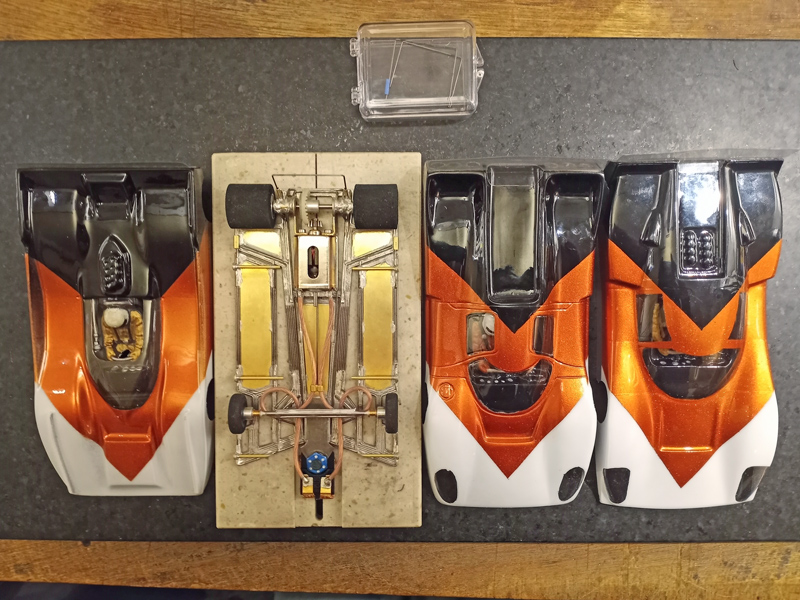CMF3 1500 Series
To misquote Mark Twain, the reports of my demise have been greatly exaggerated… However, on the specific subject of scratchbuilding slot car chassis, maybe not so much...
It’s been about two-and-a-half years since I last posted in the 1237 Series build thread. There are numerous reasons why, but the main contributor was I hit a mental roadblock on where to go next in the design and build progression. Basically it came down to the 1243, 1247, 1258, 1249, and 1256 diverging main rail/iso-guide (DMR/iG) chassis simply outperforming everything else, where it was only a question of which one had the best set-up for the track and conditions on any given day.
That is not to say I haven’t built any more 1237-series chassis, or any slot car chassis, but it was almost none. The reality is there was only one, which I built in 2023, the 1258.2a-Cb3, a purpose-built GT Coupe chassis, that would be my first GTC chassis in the DMR/iG design group, and as such was my best performer in that class, besting the lap times of the previous GTC chassis, the center main rail 1259.2a-Cb3... however, the 1258.2a-Cb3 would suffer the same fate that had befallen the 1259.2a-Cb3 exactly one year earlier... both chassis still sit on my workbench as a reminder of the tragic-comedy of existential futility... we will not speak of this, the wounds are still fresh (LOL)... Ask Jay Guard if you want to know the gory details...
But, in terms of chassis designing and building, even before that time I got to what in literary efforts would be called “writer’s block”. And at the same time I found myself spending a disproportionate amount of my time pursuing another enjoyable hobby of mine, writing. Likely most do not know this from experience, but I can confirm, it takes a lot longer to write a novel than it does to build a slot car chassis. A whole [expletive deleted] lot longer. I found this out twice. Don’t ask, you probably wouldn’t want to read them...
Writing gave me plenty of time to think about what I wanted to do as far as designing and building slot car chassis, and helped very little. However, sometime relatively early in the course of the second novel I scribbled out the idea for a chassis design, and one that had nothing to do with the 1237-Series... and there it would sit on the drafting board for more than a year...
...until February of this year. The fact this new design had nothing to do with the 1237-Series probably helped motivate me (and I wasn’t ready to go full in on the third novel yet). My penchant for overly long posts, as you can tell already, has not waned, so allow me to elucidate what this new design incorporates.
There are two main rails, angled, converging. There are still static pan sections forward of the rear tire wells. The front spanner rail has less angle than before, but still has smaller front wings in front of the front wheel wells, and having front pin mounts (6-pin technology). The side pan assemblies are wider, larger, have smaller front wheel wells, with much less movement, and can have the option of brass pans being incorporated within the steel wire framing. There is a center section between the main rails mimicking the iso-guide assembly on the DMR/iG chassis, but much larger, also giving it the option of a brass pan being incorporated. In total that allows three pans to be built into the framing, the thickness of the brass to be used variable: none, 0.010”, 0.016”, 0.025”, or 0.032”, or any combination thereof.
The all-wire frame is still being constructed with 0.032” wire, with two major variations.
First, there is a greater use of 0.039” “spine wires” soldered atop the 0.032” wire frame to stiffen the chassis around the motor-box/drive assembly, and along the front spanner rail. This chassis design was intended to be much stiffer than the 1237-Series chassis.
Second, is in the build process, where the 0.032” wire frame is built first, with everything else added to it subsequently. That includes the guide mount, front axle spanning uprights, motor bracket, and the exception, the rear axle tube, that last one always part of the original framing previously. For those who always marveled I still used my prehistoric Champion Align-O-Jig, I’m sorry to disappoint you, but this new build process allows me to use a contemporary scratchbuilding jig block. However I’m still using graph paper, numerous pieces of brass, and lots of blue tape to build the frame.
I did have a minor problem considering what to call this thing in CMF3 chassis parlance. The 1200’s had pretty much been used up by designs, especially after the 1237-Series there were only a few numbers left before I hit 1299. So I decided it was time to start a new numerical sequence, to put the new design(s) and build process in its own category, the 1500’s.
The first build would be the...
Rick / CMF3





























